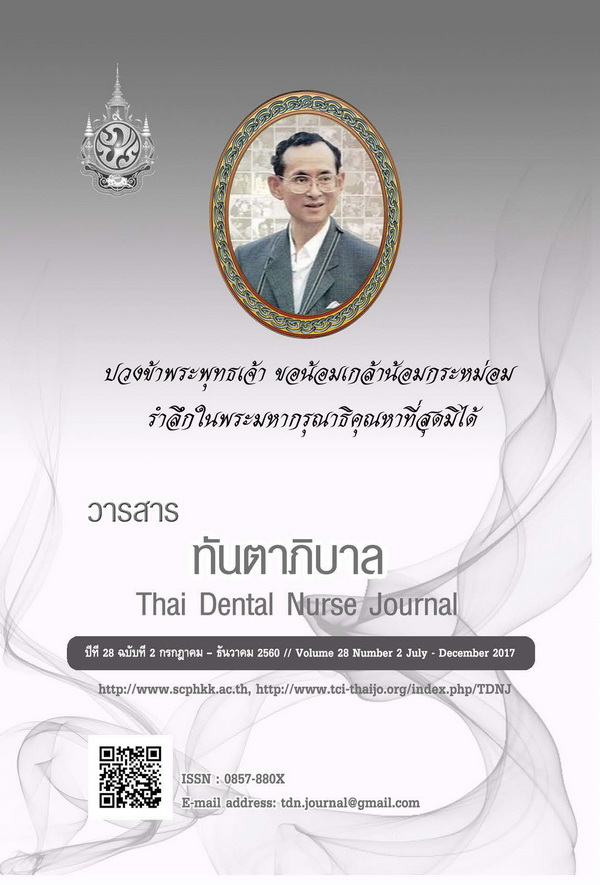The use of social networking websites integrated the Schoology platform into classroom techniques: a case study of computer for working subject of pharmacy technical students in Sirindhorn College of Public Health Khon Kaen
Keywords:
social network for education, Schoology, learning outcome, opinionAbstract
The 21st century students was growing up within the information technology (IT), to enhance the student engaging learning are concerned with integrating technology into classroom . The aims of this study were to investigate the results of applying Schoology platform into classroom, which was issues on 1) to compare learning outcome between before and after the utilization of social networking websites Schoology and 2) to study students’ opinion on the utilization of social networking websites Schoology. The students were the 44 first year pharmacy technical students who enrolled in Computer for working subject in academic year 2016. The data collecting tools were 1) learning outcome test, and 2) opinion on the utilization of Schoology questionnaire. Descriptive statistics and Paired t-test were used to analyze data.
The results showed that average learning outcome of the students before the utilization of social networking websites Schoology was 18.93 (SD 3.58), whereas the average learning outcome of the students after the utilization of social networking websites Schoology was 28.27 (SD 1.90). The assumption test indicated that the learning outcome after the utilization of social networking websites Schoology was significantly higher than before using Schoology at p-value <0.001. The student totally agreed with the integration of social networking websites Schoology into classroom learning with the score of 4.58 (SD 0.54). In conclusion, the social networking websites Schoology could arouse interest and create satisfaction in teaching-learning process among the students, thus there was positive impact on students’ learning outcome.
References
2. วรพจน์ วงศ์กิจรุ่งเรืองและอธิป จิตตฤกษ์. ทักษะแห่งอนาคตใหม่ การศึกษาเพื่อศตวรรษที่ 21. วารสารศึกษาศาสตร์ มหาวิทยาลัยมหาสารคาม2558; 9 (4):221-227.
3.ธนพล บรรดาศักดิ์และคณะ.การเป็นผู้เรียนในยุคศตวรรษที่21 : มุมมองจากอาจรย์และนักศึกษา พยาบาล.[ออนไลน์] 2559 [อ้างเมื่อ 17 กุมภาพันธ์ 2560] จาก http://www.ojs.mcu.ac.th/index.php/peace/article/view/235/193
4. JW.NugrohoJoshua. The Effectiveness of E-Learning Implementation using SocialLearning Network Schoology on Motivation & Learning Achievement in STMIK Primakara Bali.2015 [cited17Feb2017]. Available from: https://www.researchgate.net.
5. เบญจวรรณ ถนอมชยธวัชและคณะ.ทักษะแห่งศตวรรษที่ 21: ความท้าทายในการพัฒนานักศึกษา.วารสารเครือข่ายวิทยาลัยพยาบาลและการสาธารณสุขภาคใต้ 2559;3 (2):208-222.
6. Burgstrom, Laura. The Impact of Student Completion Requirements Using an LMS (Learning Management System) on Student Achievement and Differentiated Instruction in The Classroom.Education and Human Development Master's Theses. 721; 2017.
7. David Ginola and Dameria Magdalena S. The Implementation of Flipped Classroom by Using Schoology in Speaking II Class of English Education Study Program of Teacher Training and Education on Faculty of Bandar Lampung University . The Fourth International Conference on Education and Language (4th ICEL) 2016 Universitas Bandar Lampung (UBL), Indonesia; 2016.
8. ประพรรธน์ พละชีวะและจุลลดา จุลเสวก. การเสริมสร้างทักษะเมตาคอกนิชัน ด้วยเทคนิคการสะท้อนคิดผ่านเครือข่ายสังคมออนไลน์ของนักศึกษาหลักสูตรครุศาสตรบัณฑิต ในรายวิชานวัตกรรมและเทคโนโลยีสารสนเทศทางการศึกษา.วารสารบัณฑิตศึกษา มหาวิทยาลัยราชภัฏวไลยอลงกรณ์ ในพระบรมราชูปถัมภ์ 2558; 9 (3):98-108.
9. พิศมัย หาญมงคลพิพัฒน์. ผลการใช้เว็บไซต์ Edmodoในการจัดการเรียนการสอน.การประชุมวิชาการและเสนอผลงานวิจัยระดับชาติ ครั้งที่ 3 ก้าวสู่ศตวรรษที่2: บูรณาการงานวิจัย ใช้องค์ความรู้ สู่ความยั่งยืน 17 มิถุนายน 2559 ณ วิทยาลัยนครราชสีมา อำเภอเมือง จังหวัดนครราชสีมา;2559.
10.ธนะรัตน์ ธนากิจเจริญสุข. การพัฒนารูปแบบการเรียนรู้แบบยูบิควิตัสผ่านสื่อสังคมออนไลน์ สำหรับนักศึกษาระดับอุดมศึกษา.วารสารวิชาการศึกษาศาสตร์ คณะศึกษาศาสตร์ มหาวิทยาลัยศรีนครินทร์วิโรฒ. 2559; 17 (1):16-23.
11. ภิรมย์ พาบุ.ผลสัมฤทธิ์ทางการเรียนและศึกษาความพึงพอใจของผู้เรียนต่อการใช้เว็บเครือข่ายทางสังคมเพื่อการเรียนการสอน.วารสารวิทยาศาตร์ประยุกต์. 2558;14.(2): 85-94.
12. เทพยพงษ์ เศษคึมบง. ผลการเรียนด้วยอีเลิร์นนิงแบบเรียนรู้ร่วมกันผ่านสื่อสังคมออนไลน์ที่มีต่อความสามารถทางการใช้เทคโนโลยีสารสนเทศและการสื่อสารของนักศึกษาระดับปริญญาตรี.สาขาครุศาสตร์ คณะศึกษาศาสตร์.Verdian E-Journal,SU 2556; 5(2):68-82.
13. คณะครุศาสตร์อุตสาหกรรมและเทคโนโลยี. การศึกษาวิจัยเพื่อพัฒนารูปแบบการเรียนการสอน ผ่านสื่อออนไลน์. มหาวิทยาลัยเทคโนโลยีพระจอมเกล้าธนบุรี.2556[อ้างเมื่อ 7กุมภาพันธ์ 2560] จากhttp://www.bmamedia.in.th/researchdownload/cai/Fulltext.pdf
14. ณัฐกฤตา ศิริโสภณ และสาโรจน์ โศภีรักข์. การพัฒนารูปแบบการเรียนการสอนผ่านเว็บตามแนวคิดการสร้างสรรค์ด้วยปัญญา เพื่อพัฒนาการคิดอย่างมีวิจารณญาณ.วารสารศึกษาศาสตร์ มหาวิทยาลัยสงขลานครินทร์ วิทยาเขตปัตตานี.2556; 24(3): 96-120.
15. วรวุฒิ มั่นสุขผล. การพัฒนารูปแบบฝึกอบรมออนไลน์โดยการเรียนรู้แบบร่วมกัน เพื่อพัฒนาสมรรถนะการออกแบบอีเลิร์นนิง เพื่อการเรียนการสอนของอาจารย์ระดับอุดมศึกษา.วารสาร VeridianE-Journal ฉบับมนุษยศาสตร์ สังคมศาสตร์และศิลปะ.2557; 7(3): 784-799.
16.Alvin S.Sicat. Enhancing College Students’ Proficiency in Business Writing Via Schoology. International Journal of Education and Research 2015; 3 (1):159-178.
17.Vania Wibowo. Students' Perception of Using Schoology in an Argumentative Writing Class 2016.[Cited 2017 Feb 17]. Available from:http://repository.uksw.edu/bitstream
18. Adem Nalu V. Rubio. Attitude of Catanduanes State University (CSU) Students Towards Online-Integrated Teaching in Literature Using Schoology. CDRJ; l 4 (1):10-19.
Downloads
Published
Issue
Section
License
บทความที่ได้รับการตีพิมพ์ถือเป็นลิขสิทธิ์ของวารสารทันตาภิบาล





